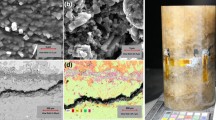Abstract
This paper describes a method of measuring the permeability of stone samples to nitrogen, applicable for studying the internal micro-structural transformations that occur in building stones when exposed to salt spray. In this method the gas enters through a previously drilled hole along the axis of a cylindrical stone sample and crosses the lateral surface by radial flux. For artificial weathering tests that affect the sample surface, this method is more suitable than the Cembureau method and gives similar permeability values. Furthermore, by changing the diameter of the hole drilled, it is possible to analyse the variations of the transfer property from the interior to the exposed surface and to study the localised effects of marine salts. The method was used during salt spray accelerated deterioration tests to asses the degree of saturation of the pores in calcareous stones traditionally used in construction in France.
Résumé
Nous décrivons dans cet article une méthode de mesure de perméabilité à l'azote mise au point pour étudier les modifications micro-structurales internes qui se manifestent dans des pierres de construction sous l'effet d'une exposition au brouillard salin. Le gaz est introduit par un trou préalablement usiné dans l'axe d'un échantillon cylindrique de pierre et traverse la surface latérale suivant un flux radial. Pour des tests de vieillissement affectant les surfaces, cet essai est plus adapté que la méthode Cembureau et fournit une mesure de la perméabilité tout à fait comparable. De plus, en jouant sur le diamètre de la perforation, on peut analyser l'évolution de la perméabilité du matériau en profondeur et au voisinage de la surface exposée et étudier les effets localisés des sels marins. La méthode de mesure a été utilisée au cours de simulations accélérées d'altération par brouillard salin, afin d'évaleur le degré de saturation de pores dans le cas de pierres calcaires traditionnellement utilisées dans la construction en France.
Similar content being viewed by others

References
Parrott, L. J., ‘Moisture conditioning and transport properties of concrete test specimens’,Mater. Struct. 27 (172) (1994) 460–468.
Bournazel, J.-P., Hermida, G. and Martinet, G., ‘Étude de la dégradation des maçonneries des greniers à sel de Honfleur par action du chlorure de sodium’,Revue française de génie civil 1 (1) (1997) 115–136.
Auger, F., ‘Simulation et étude des phénomènes de dégradation des roches calcaires en milieu aérien marin’, Proceeding of RILEM Conference on the Durability of Construction Materials, 3, Versailles, France, Sept. 1987 (AFREM French Ass. Resear. Test. Mar. & Struc. Paris), 911–914.
Torrent, R. J., ‘A two-chamber vacuum cell for measuring the coefficient of permeability to air of the concrete cover on site’,Mater. Struct. 25 (150) (1992) 358–365.
Rivas, T., Silva, B. and Prieto, B., ‘Évaluation de la durabilité de deux traitements hydrofugeant appliqués aux roches granitiques’,Materiales de Construcciand 48 (1998) 5–14.
Kollek, J. J., ‘The determination of the permeability of concrete to oxygen by the Cembureau method—a recommendation’,Mater. Struct 22 (129) (1989) 225–230.
Yssorche, M. P., Bigas, J. P. and Ollivier, J. P., ‘A non-steady state permeameter for measuring concrete permeability’,Mater. Struct. 28 (181) (1995) 401–405.
Auger, F., ‘Simulation accélérée de la dégradation des matériaux de construction en ambiance aérienne saline’, Proceeding of an International Conference on the Engineering Geology of Ancient Works, Monument and Historical Sites, Athens, 2, Sept 1988 (Greek National Group of IAEG, Athens) 797–804.
Meng, B., ‘Calculation of moisture transport coefficients on the basis of relevant pore structure parameters’,Mater. Struct. 27 (167) (1994) 125–134.
Birginie, J.-M., ‘Seawater absorption, permeability evolution and deterioration assessment of building stones subjected to marine exposure’, to be published in Proceeding of the 9th International Congress on Deterioration and Conservation of Stone, June 19–24, 2000, Venice.
Parraton, D., Aïtcin, P.-C. and Carles-Gibergues, A., ‘Mesure de la perméabilité aux gaz des bétons: perméabilité apparente et perméabilité intrinsèque. Partie I—Validation des concepts de Carman et de Klinkenberg dans le cas d'un BHP’,Bulletin du LCPC 221 (Juin 1999) 69–78.
‘Modes opératoires recommandés par l'AFREM sur la pénétration des chlorures dans le béton durci’, Laboratoire Central des Ponts et Chaussées, LCPC, France, Décembre 1996, 4 p.
Author information
Authors and Affiliations
Rights and permissions
About this article
Cite this article
Birginie, J.M., Auger, F. & Brea, T.R. Changes in the permeability to gas of calcareous stone core samples exposed to salt spray. Mat. Struct. 33, 331–337 (2000). https://doi.org/10.1007/BF02479704
Received:
Accepted:
Issue Date:
DOI: https://doi.org/10.1007/BF02479704



